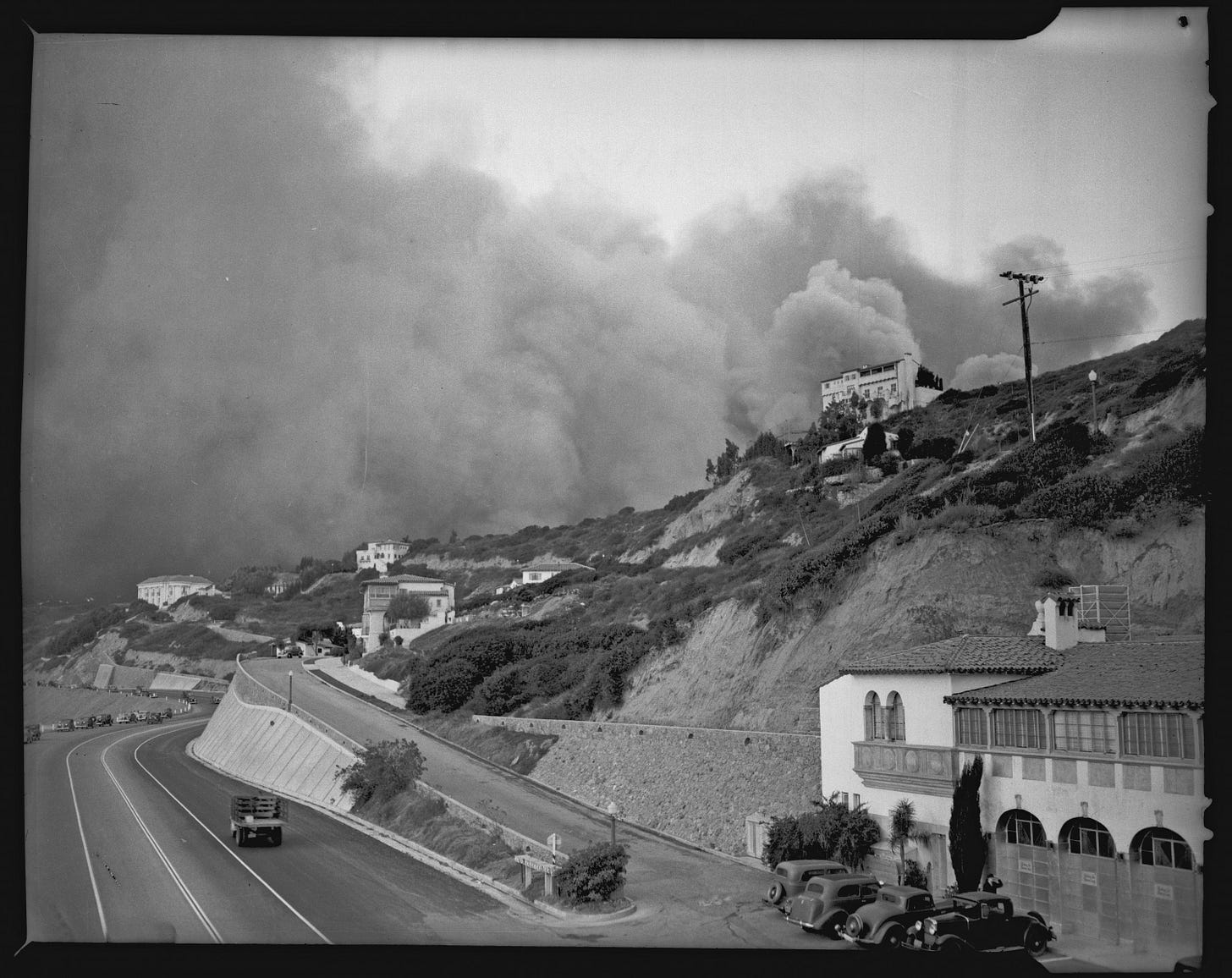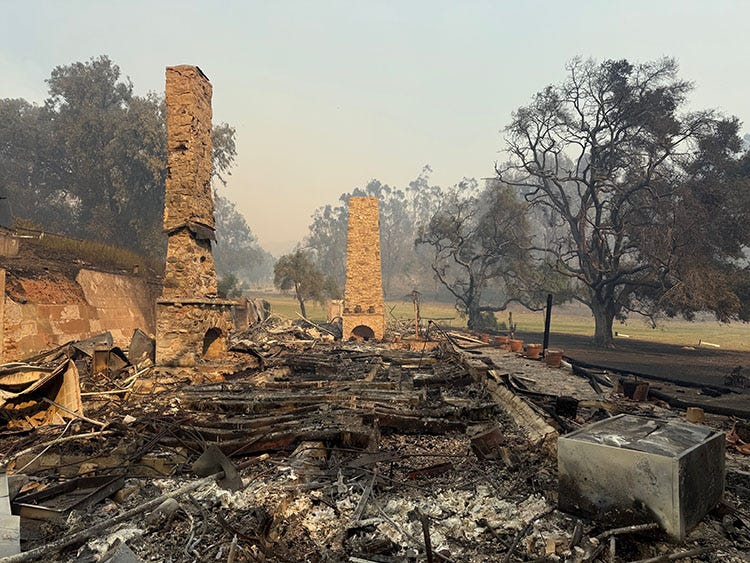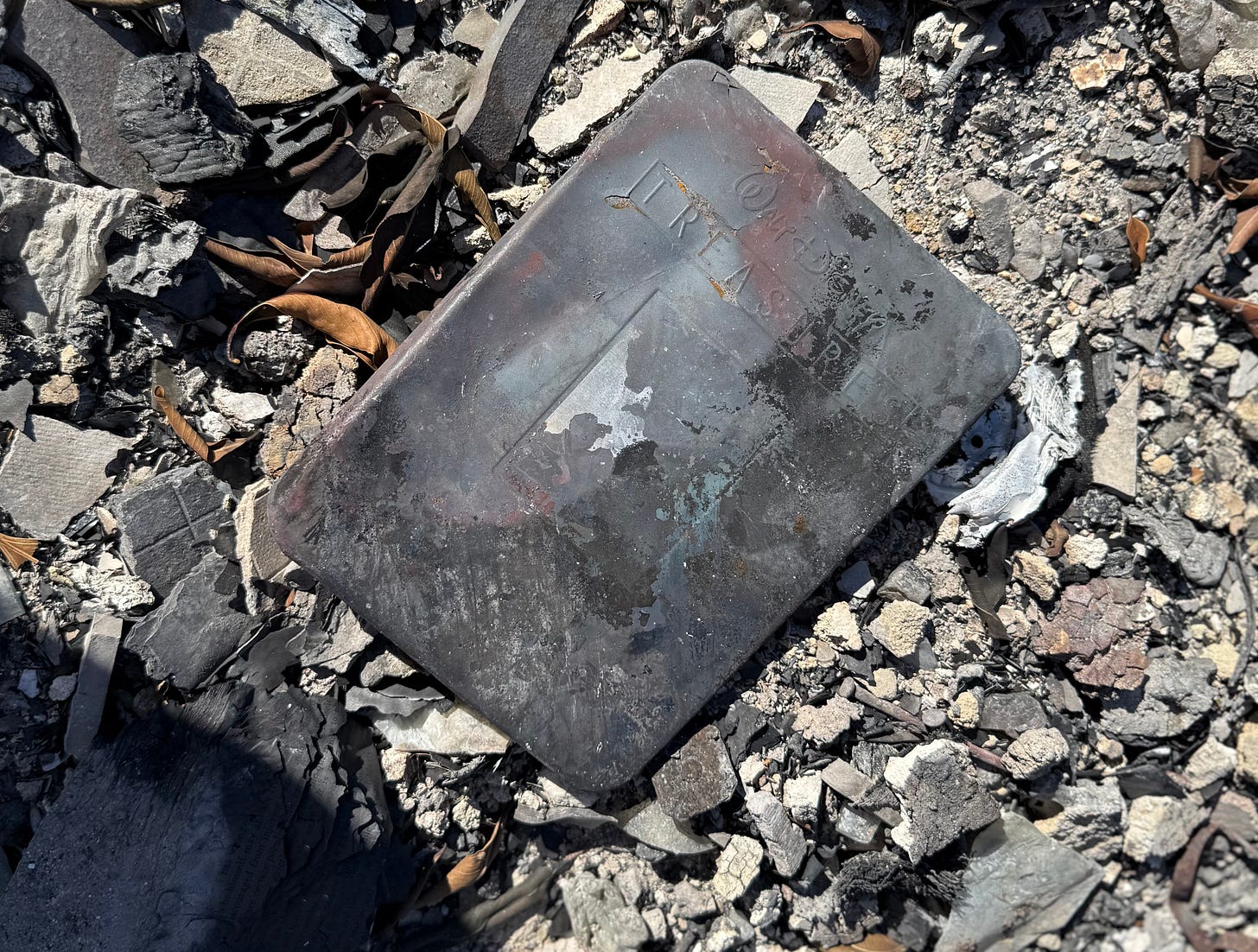
This Substack was never meant to be about me.
Then came January 7.
If you’ve listened to any Hollywood Heretic podcasts, you’ll recognize the sign-off “Make movies matter.” It was a sign-off I chose because movies have historically been most successful when they have been most meaningful in people’s lives. As George Stevens famously observed, people go to the movies less to be entertained than to learn something about themselves — because our great storytelling arts all grew out of a universal human need to make sense of life’s senselessness, to find structure, purpose and meaning in an existence which far too often feels random and meaningless. It’s a pursuit to which I’ve dedicated the greater part of my life out of the firm belief that cinema has an untapped power which is scarcely understood and rarely exercised. Life, however, has an untapped power of its own — a way of effortlessly sweeping away our best laid plans and aspirations at the most inopportune moments, as if to remind us who’s really in charge. As much as we work to convince ourselves we’re in the driver’s seat, the truth is we’re simply along for the ride — wherever it may lead.
After an eventful holiday season of merriment and movies, with Christmas gifts scarcely unwrapped, a festive New Year’s behind us and a solid twelve months of 2025 already meticulously plotted out, Tuesday, January 7, 2025 was supposed to be the day we all got back in the race. My daughter’s first day back at school after the holidays. My wife’s first post-holiday trip out of town. My time to knuckle down and knock out some witty, insightful Substacks, a week to plot next steps on a variety of other projects now that awards season — apart from the Oscars — was winding down and most of L.A.’s movie community — at least those who still had jobs following the strikes — was back at work.
The weather forecast, however, provided an already ominous indication that things wouldn’t quite transpire as expected. The entirety of the Los Angeles basin was on high alert for an unseasonably late Santa Ana wind event of historic proportions. At 6:16pm Monday evening we received the following alert from the city of Malibu:
Extremely dangerous, life-threatening wind expected in Malibu Tues 1/7 & Wed 1/8, with 50 - 80 mph, gusts up to 100 mph, hurricane-strength winds that can bring down trees, power lines and poles, damage structures, and knock over vehicles.
Wind will be strongest 10AM Tues – 4PM Wed. The National Weather Service considers this an unprecedented, historic, hurricane-strength wind event, and advises the public to stay indoors, in the first floors of structures, away from windows and trees, and off the roads. Bring outdoor furniture indoors. Park vehicles away from trees. Adjust travel plans.
Red Flag Warning, extremely dangerous fire conditions expected in Malibu 1/7 – 1/9. Be prepared for fires, evacuations, power outages, hazardous roads, and rough coastal waters.
As a native of Malibu, and my wife a native of nearby Pacific Palisades, wind events and the threat of wildfires were something with which we’d grown up. The tenor of these warnings, however, was different — almost apocalyptic. With good cause.
By morning, my daughter’s return to school had been cancelled and my wife was giving second thoughts to her departure. In the end, we decided to err on the side of optimism. We’d already had two fires this season, the second of which — the Franklin Fire — had left a massive burn scar across the middle of Malibu just three weeks prior. Fires historically threatened us from the west, never the east. Barring a conflagration of historic proportions that defied all prior patterns — the Franklin burn scar meant we could breathe a sigh of relief for a few more seasons.
Enter the conflagration of historic proportions that defied all prior patterns.
I won’t belabor the details of the next 24 hours. They are now a matter of historic record. My own experience — mirrored by that of thousands of others whose lives, possessions, homes and family histories were ravaged by the two massive Los Angeles County fires that broke out mere hours apart on January 7 — remains too painful and too harrowing to commit to print at this time. Some nine hours after it first erupted, the so-called Palisades Fire destroyed my family home and most of my immediate neighborhood. By the time it hit the Franklin burn scar — which fire officials believe was the only thing that saved thousands more from total devastation — it had destroyed more than 700 homes in the city of Malibu, more than 400 in the adjacent unincorporated area of Sunset Mesa and more than 5000 in the Los Angeles coastal enclave of Pacific Palisades, including schools, churches, legacy businesses and historic structures.
For my hometown, the Palisades Fire represented the culmination of a nearly seven year period of compounded trauma. We had already lost nearly 500 homes in the 2018 Woolsey Fire, most of which have still not been rebuilt. Combined with the impacts of the COVID-19 pandemic, our community of 13,000 was already reduced to 10,000 as of the 2020 census. In just six years time, a fourth of our community had seen their homes destroyed by fire, including between a quarter and a third of our school-age children.
Make movies matter? By the time I recorded the photograph at the top of this post, it was the last thing on my mind. Inside of the next two hours, my home, nearly all my family’s possessions, including priceless heirlooms and decades worth of movies, memorabilia and movie books were reduced to ashes. By the following morning, 70% of my neighborhood lay in ruins, one of my neighbors was dead and another lay in an induced coma to which he would finally succumb days later. Those carefully plotted plans for 2025? I’d gladly settle for one manageable day at a time.
The rapidity with which tragedy alters life’s priorities and trajectory is impossible to fathom unless you’ve gone through it. I certainly knew the drill secondhand. My mother was a war refugee. I’ve worked with Syrian War refugees. I also number many former refugees among my closest friends — from Vietnam, Iran and Lebanon — with no shortage of past fire survivors among other local friends and neighbors. But this was altogether something different. When your entire community is reduced to a war zone in less than twenty-four hours, nothing is ever again quite the same. If you have a child — it reshapes your soul. “Do I even want to own anything anymore?” runs through your mind repeatedly. If a lifetime of memories and treasured possessions can be so easily erased in an instant, what’s the point of risking it all again? Life’s carefully constructed castle begins to feel more like a sand castle at high tide.
Somewhere in the blur of days and weeks that followed, newsworthy events outside our local war zone came and went — Oscar nominations, the Oscars themselves, the death of Gene Hackman and a presidential inauguration — all of it trivial by comparison. Only the passing of David Lynch managed to penetrate our attention to any significant degree. Years ago, my wife had worked for Lynch, most notably as a production executive on Mulholland Drive (in which she also briefly appears as Naomi Watts’ hand double). We were both enormously fond of David and, like nearly everyone else in his inner circle, found his reverie intoxicating — whether at his annual holiday party or the occasional private screening. Watching David Lynch watching Eraserhead through a haze of his own cigarette smoke would have continued to be one of my favorite memories but for the fact that it was the cigarettes that finally killed him, depriving us of at least another decade of his enigmatic genius.
Between moments of shock and sadness at David’s untimely death, I flashed on the irony of the title of his Twin Peaks feature prequel, which I had seen my first year at the Cannes Film Festival in 1992: Twin Peaks: Fire Walk with Me. More than a week later, the Palisades Fire still walked with me — stalking me as surely as the supernatural evil emanating from the inter-dimensional Black Lodge to which Lynch’s title is a reference.
While I don’t subscribe to the adage that “time heals all wounds,” I do believe that time enables us to build the resolve and forbearance with which we learn to care for and live with our wounds. As any trauma survivor will concede, the worst wounds never really heal. We simply learn to channel our pain for good — and push forward. The sheer scale of the devastation makes it simultaneously worse and better — worse because such an enormous vault of cultural and communal heritage has been needlessly incinerated — but better because a shared burden is always a lighter burden. By that metric, having just passed the one-hundred day mark since the fire, it’s impossible to concede that things have not become incrementally more manageable. Efforts towards rebuilding the devastated communities are making slow but steady progress — bureaucratic obstacles notwithstanding — and all of us, from Altadena to Pacific Palisades to Malibu — are sharing with and learning from each other along the way.
As I return to authoring regular essays in this space, including the final two entries in the three-part “Celebrity and the Art of Self-Immolation,” I will invariably be writing from a very different perspective on life and art from the one I had when I began this Substack. For starters, the burn area (which I drive through several times a week) has deep Hollywood roots. Beyond the well-reported impact the fire had on celebrities, filmmakers and executives who also lost their homes, the center of the Palisades Fire burn scar, in and around the intersection of Pacific Coast Highway and Sunset Blvd., was once home to one of the very earliest studio lots — Thomas Ince’s famed Inceville, built in 1912 and, in a great stroke of irony and fate, largely destroyed by fire in 1922. The same area was also central to the life of famed Hollywood dance director and filmmaker Busby Berkeley, whose story my wife and I are preparing to tell on screen. Just a few hundred meters to the west of that intersection, at the base of the Castellammare neighborhood, sits the structure that was once home to actress Thelma Todd’s eponymous sidewalk café (later the home of producer/priest Ellwood Kieser’s Paulist Productions), which sits directly below the garage (owned by her occasional boyfriend, film director Roland West) where Todd was found dead in December of 1935, (allegedly) accidentally asphyxiated in her car at the age of 29. Higher up, overlooking both Thelma Todd’s and Pacific Coast Highway, is the magnificent bluff-side mansion that was once home to actor Joseph Cotton. Both structures as well as the historic Villa de Leon (and the nearby Getty Villa museum) were spared, as they were the last time fire swept through the area in 1938. Most of the surrounding homes, however, were not.

Also not so fortunate was Will Rogers’ ranch house, part of Will Rogers State Park and a longstanding historic and cultural landmark.

The lesson, as always, is that fire, like fate, is random. While the Palisades and Eaton Fires laid waste to much of Los Angeles’ and Hollywood’s oldest cultural artifacts, they mercifully spared others. Nearly every great city on earth has a similar story to tell — the 50,000 capacity Roman Colosseum (known as the Flavian Amphitheatre in antiquity) stands to this day. But the even greater Circus Maximus, where as many as 250,000 would gather to watch the great chariot races made famous in William Wyler’s 1959 Oscar-winning Ben-Hur, today lives only as an echo and a movie memory; the field where it once stood littered with a smattering of old stones that barely count as ruins. The Pyramids of Giza, over 4,500 years old, stand watch over the city of Cairo to this day while the great Library at Alexandria, after centuries of fires, invasions and lootings, has long since vanished into lore and myth. The Library of Congress estimates that over 75% of our silent film heritage is lost forever, while Martin Scorsese’s Film Foundation puts that figure close to 50% of all American films made before 1950, and 90% made before 1929 (including two silent films in which my father once had a part).
As I personally struggle with the erasure of a huge portion of my life and my family’s history — irreplaceable records, memoirs, artifacts and heirlooms — a struggle faced by thousands of other fire survivors in Los Angeles — the bigger picture is both equally painful and sobering. This is how it has always been. Some survive. Others don’t. Beyond that, any attempt to find rhyme, reason or meaning in the randomness of tragedy is fuel for frustration and anger. We move on. We press forward. We mourn and cherish the memories of what we have lost while clinging resolutely to what we have saved. In the process — we look for meaning elsewhere, in our relationships, our achievements, our hopes and dreams. Most importantly, we look for meaning through the arts — as artists and consumers of art. What we find there, even whether we find anything at all, is up to us. Again, to cite George Stevens, our quest is to learn something about ourselves. To learn, however, one must be teachable — and to be teachable, one must be humble. Speaking from fresh and painful experience, there is little more humbling than losing everything in the blink of an eye.
As I move forward, as my family moves forward, as our crippled community and industry move forward, may we all find the resolve to raise a phoenix from both the literal and proverbial ashes — a cultural renaissance to balm our savaged souls and bring hope to a wounded generation, that the arts we have so long neglected and taken for granted — in particular our great and waning tradition of cinema — might once again find a rightful place at the center of our noble search for meaning.






Thank you for sharing your grief and grace.
I pray this tragedy will not just bring pain but help show us all purpose and a way forward so our collective souls can blossom and grow stronger together.
You are a gift to our community and I am grateful for you!
Love always-
That was simultaneously heartbreaking and beautiful to read. I’m so sorry you and Kristi and Hero had to go through that.